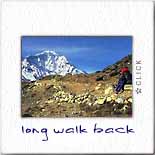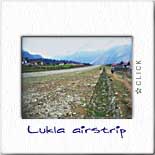
from Namche to Thyangboche
Map
of the Khumbu
The Gear
that got us there
April 1:
Kathmandu
April 2:
Kathmandu
April 3:
Kathmandu
April 4:
Lukla and Phakding
April 5:
Namche
April 6:
Between Namche and Thyangboche
April 7:
Thyangboche
April 8:
Thyangboche
April 9:
Dingboche
April 10:
Dingboche
April 12:
Lobuche
and
Beyond
Trek photos by Peter Potterfield, © 1997 The Zone Network. All rights Reserved.
![]()

 For many, Lobuche is the end of the line. Independent trekkers usually
make one day trip from here, a few miles up the valley to the former yak
herders' village of Gorak Shep. There the small, blocky rise known as
Kala Pattar affords the only unobstructed view of Everest since
Thyangboche. For climbing expeditions and Everest Base Camp treks, there
are two options from Lobuche: spend one night at Lobuche, then one night
at Gorak Shep, then the four hours on to Base Camp. Or spend two nights
at Lobuche and then make the trip to base camp in one long day. High
altitude and extreme cold make the time spent beyond Lobuche a hardship
for most trekkers. For climbers, of course, arrival here is really only
the beginning of the long process to acclimate.
For many, Lobuche is the end of the line. Independent trekkers usually
make one day trip from here, a few miles up the valley to the former yak
herders' village of Gorak Shep. There the small, blocky rise known as
Kala Pattar affords the only unobstructed view of Everest since
Thyangboche. For climbing expeditions and Everest Base Camp treks, there
are two options from Lobuche: spend one night at Lobuche, then one night
at Gorak Shep, then the four hours on to Base Camp. Or spend two nights
at Lobuche and then make the trip to base camp in one long day. High
altitude and extreme cold make the time spent beyond Lobuche a hardship
for most trekkers. For climbers, of course, arrival here is really only
the beginning of the long process to acclimate.
| Suddenly and wonderfully, I was just a guy walking through the Himalaya. |
 For me, the walk out was a tremendous relief because all the uptight
work was finally over. I left the satellite phones and laptops and solar
panels and dispatch responsibilities with Todd Burleson, Wally Berg and
the other members of the 1997 American Everest Expedition. Suddenly and
wonderfully, I was just a guy walking through the Himalaya. Mohann, a
Rai porter (Rai is a subculture of Nepal, as Sherpas are) and I began
our journey early one morning. By mid-afternoon we had reached the
windswept village of Pheriche, which was new to me as on the way in our
group had stayed in more sheltered Dingboche, just over the hill.
Pheriche is home to the only clinic in the upper Khumbu, staffed by
volunteer Western physicians. Here we spent the night in a lodge,
racking hard and luxuriating in the thicker atmosphere.
For me, the walk out was a tremendous relief because all the uptight
work was finally over. I left the satellite phones and laptops and solar
panels and dispatch responsibilities with Todd Burleson, Wally Berg and
the other members of the 1997 American Everest Expedition. Suddenly and
wonderfully, I was just a guy walking through the Himalaya. Mohann, a
Rai porter (Rai is a subculture of Nepal, as Sherpas are) and I began
our journey early one morning. By mid-afternoon we had reached the
windswept village of Pheriche, which was new to me as on the way in our
group had stayed in more sheltered Dingboche, just over the hill.
Pheriche is home to the only clinic in the upper Khumbu, staffed by
volunteer Western physicians. Here we spent the night in a lodge,
racking hard and luxuriating in the thicker atmosphere.
When I went into the tea house dining room for breakfast the next morning, a body in a sleeping bag squirmed free and revealed itself to be Nima Sherpa. Nima had worked for my friend Scott Fischer during the tragic 1996 Everest climb, and we had met at the memorial service for Scott in Seattle. As they say, it's a small world.
 Mohann and I resumed our journey, reaching Thyangboche by lunch time and Namche Bazaar by dinner. We arrived at the Panorama Lodge in a pouring
rain, and the warm welcome we received there was like coming home. The
next day was spent down in the forest zone, amazingly green after so
long above tree-line, walking down from Namche through Phakding to Lukla.
I was lucky on weather, and after only one night in Lukla climbed into
the Everest Air MI-17 helicopter for the ride back to Kathmandu. Waving
farewell to Mohann as we lifted off, I pondered the previous 28 days
and knew it was going to take some time to process this experience.
Mohann and I resumed our journey, reaching Thyangboche by lunch time and Namche Bazaar by dinner. We arrived at the Panorama Lodge in a pouring
rain, and the warm welcome we received there was like coming home. The
next day was spent down in the forest zone, amazingly green after so
long above tree-line, walking down from Namche through Phakding to Lukla.
I was lucky on weather, and after only one night in Lukla climbed into
the Everest Air MI-17 helicopter for the ride back to Kathmandu. Waving
farewell to Mohann as we lifted off, I pondered the previous 28 days
and knew it was going to take some time to process this experience.
While Peter's journal ends here, you can continue the story with The Mountain Zone's fully archived cybercast coverage of Everest Expeditions. Read the dispatches, see the photos, listen to live audio from the mountain (including the summit) and explore what it means to climb Mount Everest.